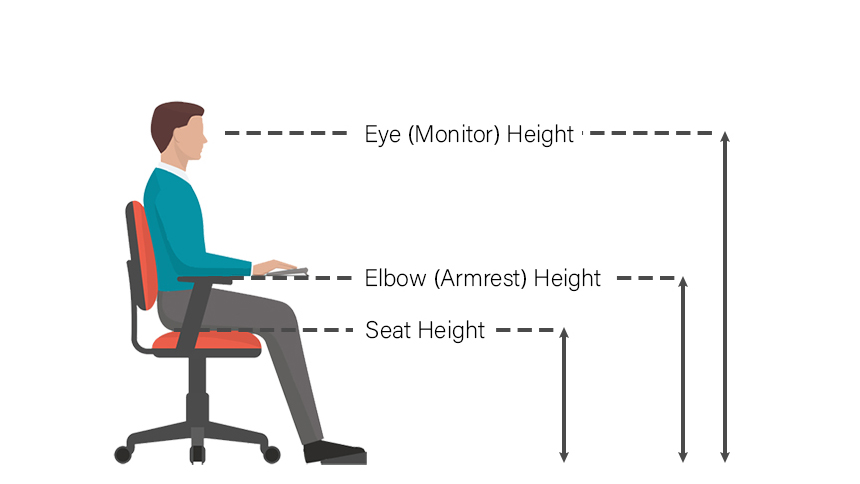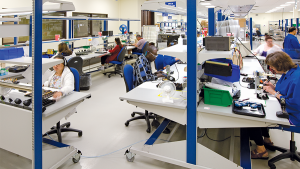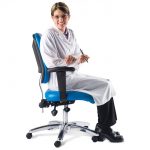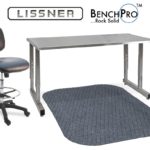Table of Contents
How Do I Choose the Right Industrial Task Chair?
If you’re not sure which chair to buy for your facility or commercial production environment, you should start with the application. Defining how and where the chair will be used narrows down choices and solutions.
What are Industrial Task Chairs?
Static controlled seating is just one type of industrial task chair that excels for multi-shift environments. Industrial chairs are built for good ergonomics, heavy use, and long life. Industrial task chairs are an investment and are designed for maximum durability and worker safety. If you are looking for a seating application in one of the industries listed below, these chairs will be the best solution for you:
- Manufacturing: Facilities that require long sitting periods & consecutive shifts.
- Science & Education: Laboratory and Research facilities.
- Healthcare: Nurse Stations & Exam Rooms.
- Public Service: Security Stations & Checkpoints.
- High Capacity: Workers in the 1-5 and 95-99 percentiles in weight & height.
Health Issues and Ergonomic Seating
A well-designed industrial task chair chair for the operator is one of the most important parts of a work station. It can favorably affect posture, circulation, the amount of effort required to maintain a position, and the amount of pressure on the spine.

Any job or activity that requires a fixed position over a long period of time can cause musculoskeletal discomfort. Poor job and workplace design contribute to many reported discomforts which are also found in other occupations.
A key to preventing such discomforts is to assume a range of comfortable positions and to have adjustable furniture, such as the chair, display table and keyboard support. However, the degree of adjustability for any furniture and visual display depends on how long and for what purpose they will be used. Prolonged work in the same position, whether seated or standing, can cause discomfort. Where possible, movement should be incorporated into the task to prevent discomfort and fatigue.
Benefits of Proper Ergonomic Seating

"Proper sitting contributes to the physical well-being of a worker. It may also add as much as 40 minutes of production to each work day if the chair is properly selected and customized to support the lower back."
N.C. Department of Labor Occupational Safety and Health Program Report - A Guide to Ergonomics; Cherie Berry, Commissioner of Labor, OSHA State Plan Designee
10 Rules for Choosing the Right Ergonomic Chair
1.
Task chairs should have pneumatic seat height adjustment. This allows the seat height to be easily adjusted, acts as a shock absorber when sitting down and allows the chair to swivel so you don’t have to twist your back when reaching for things. A brand name gas lift from one of the original manufacturers is advisable, as many lower priced versions are unproven at best.
3.
The seat pan should tilt forward and backward, should lock into any position to provide the variation in postures required by the human body, and have a tilt tension control if the seat has a free float mode.
4.
- The seat size must allow the user to sit back against the backrest while leaving approximately a three-finger width of clearance between the back of the knees and front of the seat.
- The seat should have a waterfall (curves downward) front edge to reduce pressure on the veins beneath the thighs and should subtly curve up at the sides to redistribute the user’s weight away from their seat bones.
- The seat should not be ‘dished out’ (dip inward in the center), which puts pressure on the veins beneath the thighs and should not rise up at the back middle portion of the seat pan, as that puts extra pressure on the base of the spine.
- The seat pan depth should be adjustable.
5.
- The backrest must have lumbar support built into its structure, not just the foam, as foam alone cannot provide the force necessary to re-position the lumbar spine back into its natural curvature.
- The backrest must also have lateral curves to support the upper body, so as to reduce the amount of muscle activity required to keep it in the upright posture.
- The backrest should be covered with foam to avoid a hard structure that comes in direct contact with the user’s back. Hard edges cause discomfort for some users.
- The backrest should be the correct size for the length of the person’s back.
6.
7.
8.
- Allow the user to pull their chair close to their work surface.
- Support the weight of the user’s arms to reduce stress on the shoulders and neck.
- Provide guidance and support when getting in and out of the chair.
9.
10.
How to Measure for Proper Seat Height
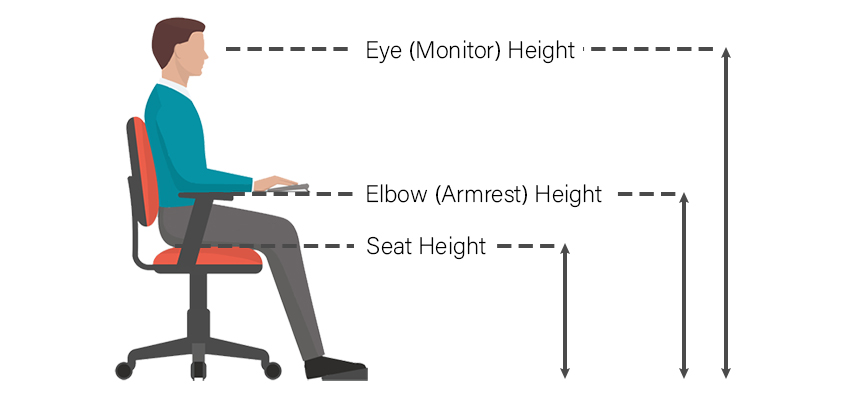
Seating Height Chart for Ergonomic Task Seating
| User Height | Seat Height | Elbow (Armrest) Height | Eye (Monitor) Height |
|---|---|---|---|
| 5’0″ | 14″ | 22.5″ | 41.5″ |
| 5’1″ | 14.5″ | 23″ | 42″ |
| 5’2″ | 15″ | 23″ | 43″ |
| 5’3″ | 15″ | 23.5″ | 44″ |
| 5’4″ | 15.5″ | 24″ | 44.5″ |
| 5’5″ | 15.5″ | 24.5″ | 45″ |
| 5’6″ | 16″ | 25″ | 46″ |
| 5’7″ | 16.5″ | 25″ | 46.5″ |
| 5’8″ | 16.5″ | 25.5″ | 47.5″ |
| 5’9″ | 17″ | 26″ | 48″ |
| 5’10” | 17″ | 26.5″ | 48.5″ |
| 5’11” | 17.5″ | 27″ | 49″ |
| 6’0″ | 18″ | 27″ | 50″ |
| 6’1″ | 18″ | 27.5″ | 50.5″ |
| 6’2″ | 19″ | 28″ | 51.5″ |
| 6’3″ | 19″ | 28.5″ | 52.5″ |
| 6’4″ | 19.5″ | 28.5″ | 53″ |
- We diligently choose suppliers and sell only the chairs that align industrial and specialty needs.
- We 100% stand behind all of our products.
- You’ll enjoy not only great pricing but also great customer service.
- Select from hundreds of base chairs on our site. Each chair allows dozens of customizable accessories, making tens of thousands of possible combinations.
- We have the best possible pricing available for all of our suppliers.
- Our product specialists have superior knowledge about the items we sell.
Related Posts
-
Industrial Task Seating: Why Durability Matters for the Lowest Total Cost of Ownership
For 20 years, ergoCentric has been committed to providing the lowest total cost of ownership in the industry - not the lowest price, or the coolest looking chairs, although both price and aesthetics are important.…
-
BioFit and Seating Ergonomics
Ergonomics is a topic we've covered numerous times on the Production Automation blog, but it is a topic that is relevant in so many industries. Whether you work on a production floor in a factory…
-
15% Off Chair/Anti-Fatigue Mat with BenchPro Workbench Purchase
Select your BenchPro workbench, and save 15% on any anti-fatigue mat or Lissner chair.
- Product Spotlight: BioFit Intensive Plus Chair
Well-fitting and properly adjusted seating is essential for working productively and safely. A good chair provides support to the user's back, legs, buttocks, and arms while reducing the chance of contact stress or postures that…
-
Industrial Task Seating: Why Durability Matters for the Lowest Total Cost of Ownership
For 20 years, ergoCentric has been committed to providing the lowest total cost of ownership in the industry - not the lowest price, or the coolest looking chairs, although both price and aesthetics are important.…
-
Industrial Task Seating: Why Durability Matters for the Lowest Total Cost of Ownership
For 20 years, ergoCentric has been committed to providing the lowest total cost of ownership in the industry - not the lowest price, or the coolest looking chairs, although both price and aesthetics are important.…

